Bound with leaves from the Bible; identifying “paper wrappers”
Cambridge University Library possesses four copies of the Ninth German Bible, considered to be one of the most beautiful of all German Bibles, printed in Nuremberg by Anton Koberger in 1483. Koberger is most well known as the printer of the Liber Chronicarum (Nuremberg Chronicle) and this Bible is no less splendid a production, and on a similarly grand scale. The Incunabula Short Title Catalogue lists nearly 300 extant copies, in varying degrees of completeness, and estimates of the print run range from 1000 to 1500. The text was taken primarily from the Fourth German Bible printed by Zainer in Augsburg in 1475 while the 109 images were produced using woodcuts by the Master of the Colgone Bible; Koberger purchased these after they were first used by Heinrich Quentell for his Low German Bible (Cologne, 1478).
The first copy to reach the UL was bought prior to 1853 through the Worts fund, a benefaction received in 1709 which has been used greatly to enrich the Library’s holdings of incunabula. The second had belonged successively to the great collectors Henry Huth and Arthur Young, the latter of whom gave it to the Library as part of his remarkable 1933 benefaction. The remaining two copies are part of the collections of the Bible Society, one previously owned by a Jesuit house in Bamberg.
The library also possesses four books bound in what can now be identified as leaves from this same Bible; Oates listed them only as “in paper wrappers”. Three had belonged previously to Sir Stephen Gaselee, who gave the Library over 300 incunabula, primarily in 1934 but also over successive years until his death in 1943. Gaselee was a remarkable collector, with a fascination for the smaller printers and less well known printing towns; he owned 14 books from Austro-Hungarian printers, and according to Oates’ introduction showed these to a visiting Archduke who was much taken aback to see them ‘in the flesh’. While Oates did not identify these binding fragments, the text is clearly from a German translation of the Bible, and the first of the volumes encountered while cataloguing includes the beginning of the 17th chapter of a book beginning with a reference to “A man from Mount Ephraim whose name was Micah”. This enabled the identification as the 17thchapter of the Book of Judges. The Library’s extensive holdings of early German Bibles made identification of the specific edition a straightforward process of elimination.Gaselee’s three volumes were all printed in Vienna by Johann Winterburg; Inc.4.G.6.2[4104] is Cultrificis’s Defensorium privilegorum fratrum mendicatorum, printed ca 1499-1500. Inc.5.G.6.2[4108] is Peuerbach’s Algorismus, also dated to 1499-1500, and the third is Inc.5.G.6.2[4101], Dati’s Elegantiolae, ca 1494. The leaves used for their bindings would have been close together in the original Bible; leaf cvii on the Cultrificis, cxiii on the Dati, and cxx on the Peuerbach. The source of Gaselee’s three copies was the Viennese Kunstantiquariat Ignaz Schwarz, and all contain Gaselee’s own handwritten note giving the date of purchase and price paid: £10 each, in August 1934.
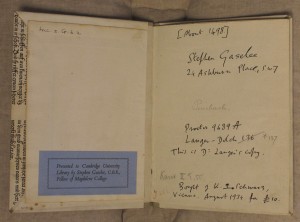
Inscriptions by Eduard Langer and Stephen Gaselee in Inc.5.G.6.2[4108] (click image for full-size version)
It is difficult to establish for certain the date at which the Bible sheets were added to the covers of the three pamphlets. It might be a reasonable conclusion that Schwarz was the source of the bindings and the fragments used for them. If Langer had been the one to do this, using a (perhaps incomplete) Bible in his own possession, he might have decorated more of his volumes in this way. Certainly it is suggested in Buzas, German library history 800-1945 that “Eduard Langer … drew up his own bookbinding method for his library”, but no more details are given.
The story becomes more intriguing, however, with the discovery of another item bound in a fragment from the same Ninth German Bible; not necessarily, of course, the same copy. This is a copy of Udalricus Ebrardi. Modus latinitatis (Memmingen: Albrecht Kunne, 1489) at classmark Inc.5.A.23.1[4600]. This is bound with a fragment of leaf cccxciv of the Bible. It was bought from L. Rosenthal in 1985, but bears no other signs of previous ownership of history. Might this also have been bound into a fragment by Ignaz Schwarz? The edges of this copy have been coloured red, unlike the three Viennese titles. We might note that Albrecht Kunne began his printing career in Trent before moving to Memmingen. This is probably no more than a coincidence, however.According to the Index Possessorum Incunabulorum the National Museum in Prague purchased a section of Eduard Langer’s library, including 36 incunabula. These bear his stamp, unlike our copies. Do any other libraries hold books with marks of ownership tracing their holdings to Langer or Schwarz, or any other fragments of this Bible used as bindings? We would be delighted to hear from you.
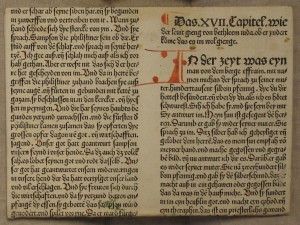
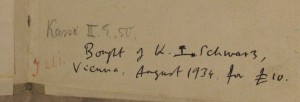
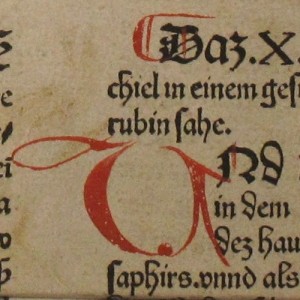
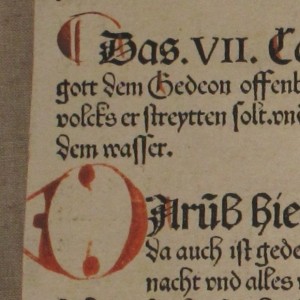
Dear Emily, colleagues at CUL:
As it happens, just last year my colleague Oliver Duntze catalogued a large number of incunabula fragments preserved “in-situ” – in the bindings themselves – in our inc collection here at Berlin State Library.
Oliver found no less than five examples of 20th(?)-century bindings consisting of fragments of Koberger’s 1483 German Bible, but unfortunately we haven’t yet come around to do in-depth provenance/accession research on these items. Munich SB has a couple of similar volumes, and other libraries as well, I suppose; sometimes fragments from other Koberger editions were also used.
Here’s a list of digital images that we’ve found so far:
Allendale UL:
http://gvsu.cdmhost.com/cdm/compoundobject/collection/p188901coll2/id/347
Munich:
http://daten.digitale-sammlungen.de/bsb00070679/image_1
http://daten.digitale-sammlungen.de/0006/bsb00062017/images/
http://daten.digitale-sammlungen.de/bsb00071520/image_5
http://daten.digitale-sammlungen.de/bsb00066758/image_5
http://daten.digitale-sammlungen.de/bsb00011537/image_1
http://daten.digitale-sammlungen.de/bsb00071515/image_1 http://daten.digitale-sammlungen.de/bsb00071516/image_1
As for another possible origin of this kind of binding, please consider Joseph Dane, What is a Book?, Univ. of Notre Dame Press, 2012, p. 168, referring to Otto Vollbehr: “There are, on the Huntington shelves, many slim incunables from Vollbehr sales bound with paper covers that were made from leaves of early printed books and, in several instances, from leaves of the same book.”
I’ll be in Cambridge in the first week of July and will gladly take a look at the CUL volumes in question.
Interesting subject!
Best, Falk
Many thanks for your extremely helpful reply and what a timely cataloguing coincidence! I will look into the books you mention and the Vollbehr reference, and see if any more books bound in this Bible can be discovered.
Here’s another one that looks as if it came from the same source: http://www.bibliotheque-desguine.fr/Ressources/Desguine/Pdf/A00145.pdf = GW M12417, copy in Nanterre.
Best, Falk
I just came across the Cambridge Blog site, and I’m very happy to know of it. I have something I can contribute concerning incunables in modern bindings using waste from the Koberger German Bible as the covering material. In checking the records from my census project of incunable bindings in American libraries, and see that there have been about 90 copies in numerous libraries with this Koberger printed waste covering. I haven’t investigated this subject in any way, other than to compile a list of copies. If anyone is interested in delving into this matter further, I’d be happy to provide a list of libraries and shelf numbers for these incunable copies. For example, there are 6 copies in the Houghton Library at Harvard, 4 at Columbia, 7 at Bryn Mawr College, 10 in the Morgan Library, about 30 in the Beinecke Library at Yale, to name only a few.
Best, Scott
Dear Scott, this is truly wonderful! We would be very interested to know more about your discoveries in American collections, please could you email me at ejm25@cam.ac.uk?
Many thanks indeed,
Emily
Dear Scott,
Wonderful indeed! When you prepare the list for Emily, please send an email copy to me at falk.eisermann@sbb.spk-berlin.de.
Best, Falk
Dear Scott and Falk, thank you both for your information. We would be grateful if Scott’s list could also be sent to the Incunabula Project e-mail address, which is incunabula@lib.cam.ac.uk. With many thanks,
Laura